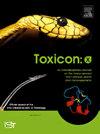Evaluation of Stemona collinsiae root extracts for topical cockroach control: adulticidal, nymphicidal, and chemical distribution analysis
IF 2.8
Q2 TOXICOLOGY
引用次数: 0
Abstract
Stemona collinsiae root extracts have been scientifically shown to exhibit antifeedant, growth inhibitory, larvicidal, pupacidal, and adulticidal activities in pests and insect vectors. In this research, contact toxicity of hexane, dichloromethane, ethanol, and water extracts was repeatedly tested on final-instar nymphs and adult Periplaneta americana using a topical application method and the penetration and distribution of didehydrostemofoline were detected at each of the specified times using MALDI-IMS and HPLC. Dichloromethane extract, which contained the highest didehydrostemofoline content, exhibited the highest contact toxicity against final-instar nymphs (41.0–100.0 % corrected mortality) and adult Periplaneta americana (23.0–46.0 % corrected mortality), while P. americana exposed to the water extract survived (0.0 % corrected mortality), similar to negative control group (0.0 % corrected mortality). Signs of toxicity such as excited movement, tremors, depression, motionlessness, expanded abdomen, and affected alimentary canal were observed in P. americana exposed to dichloromethane and hexane extracts. MALDI-IMS images showed that didehydrostemofoline was able to distribute from the sectioned first-abdominal segment to the sectioned head segment. HPLC chromatograms of the extracts of abdominal integument, lipid layer, alimentary canal, and head segment, it revealed that didehydrostemofoline initially adhered to the epicuticle, then penetrated through deeper layers of the integument and was distributed to other tissues. Therefore, P. americana could absorb didehydrostemofoline via topical administration, which was subsequently distributed and transported to other tissues. S. collinsiae dichloromethane root extract containing didehydrostemofoline could potentially be used as active ingredients in cockroach control.

山菖蒲根提取物局部灭蟑效果评价:杀成虫、杀雌及化学分布分析
科学研究表明,山参根提取物对害虫和昆虫媒介具有拒食、抑制生长、杀幼虫、杀蛹和杀成虫的活性。本研究采用外用法反复检测己烷、二氯甲烷、乙醇和水提取物对美洲大蠊末龄若虫和成虫的接触毒性,并采用MALDI-IMS和HPLC检测在规定时间内双脱氢茎油啉的渗透和分布。二氯甲烷提取物对末龄若虫(41.0% ~ 100.0%校正死亡率)和美洲大蠊成虫(23.0% ~ 46.0%校正死亡率)的接触毒性最高,而暴露于水提取物的美洲大蠊存活(0.0%校正死亡率),与阴性对照组相似(0.0%校正死亡率)。暴露于二氯甲烷和己烷提取物的美洲大蠊出现兴奋运动、震颤、抑郁、运动迟缓、腹部扩张和消化道受累等中毒症状。MALDI-IMS图像显示,双脱水stemofoline能够从切片的第一腹段向切片的头部段分布。腹部被膜、脂质层、消化道和头段提取物的HPLC图谱显示,双脱水茎ofoline最初粘附于表皮外皮,然后穿透被膜较深层,向其他组织分布。因此,美洲蓟马可以通过局部给药吸收双脱氢茎ofoline,并将其分布和运输到其他组织。二氯甲烷根提取物含有二脱氢茎油碱,可作为防治蜚蠊的有效成分。
本文章由计算机程序翻译,如有差异,请以英文原文为准。
求助全文
约1分钟内获得全文
求助全文
来源期刊

Toxicon: X
Pharmacology, Toxicology and Pharmaceutics-Toxicology
CiteScore
6.50
自引率
0.00%
发文量
33
审稿时长
14 weeks
 求助内容:
求助内容: 应助结果提醒方式:
应助结果提醒方式:


